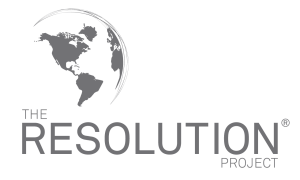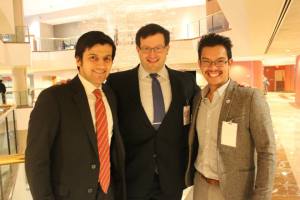
Last week, Best Delegate had the opportunity to sit down with George Tsiatis and Oliver Libby, two of the co-founders of Resolution Project, an organization geared toward providing resources and guidance for various social ventures created by college students. George Tsiatis and Oliver Libby were both heavily involved with their Model UN Program during their college years; staffing various conferences from HNMUN to World MUN. Through their experience competing in Model UN and working behind the scenes, Tsiatis and Libby realized that the ideas and solutions that delegates spend months researching and debating all disappear at the end of the conference. Therefore, while reminiscing about Model UN and searching for ways to realistically implement the solutions created during committee, came the inception of Resolution Project.

Ryan with two of the co-founders of Resolution Project, George Tsiatis (left) and Oliver Libby (center).
What is Resolution Project?
Resolution Project is an organization geared toward providing the resources and opportunities for students to make a positive impact in their community in order to create a generation of leaders committed to social responsibility. More about the process of how to be awarded as a Resolution Fellow is outlined below.
Tsiatis and Libby further commented on the origins of its name. Combining two key words, Resolve and Solution, Resolution Project, stresses the two components of their work, an individual’s goal and dedication. Fellows must have a feasible idea to work off of, but they also need to have resolve, dedication and passion for their venture. Through the combination of these two words, the Resolution Project has shown its impact to developing the leaders of today.
Where did it begin?
In 2007, Resolution Project went to World MUN out in Geneva to speak to delegates about social entrepreneurship, gauging how they could help delegates take their ideas and apply it to the real world. Then the next year at World MUN in Puebla, Mexico – it ran a mini case challenge, asking for delegates to address a problem within your committee and a solution to it. With around 60 submissions, the organization realized the impact of its mission and worked to provide the funds, resources, and tools necessary to equip these motivated social entrepreneurs. In 2009, Resolution Project held it first, official competition and awarded five fellowships for three unique social ventures.
With its mission to create a generation of leaders with a lifelong commitment to social responsibility, Resolution Project
challenges the statement of rearing “leaders of tomorrow” and instead provide opportunities for individuals to become “leaders of today”. To equip the students today who are dedicated to changing the world, so that they have experience for when they graduate and work to solve other problems in the world. Libby states that “at resolution, you will be able to start today, to not only be tomorrow’ leaders, but today’s leaders.”
How does it work?
Resolution Project mainly functions through a multi-step competition called the Social Venture Challenge (SVC). First, before the conference, teams sign up and submit a proposal that outlines their venture implementation. Next, at the conference the selected semi-finalists will showcase their proposal to a panel of judges in a science fair-like setting. Last, at finals the judges will select the finalists to present to judges with a question and answer session afterwards. At the end of the SVC, several Resolution Fellows are chosen, being awarded with a grant reward of around $3,000, given a mentor for their project, and provided access to a network of various organizations and fellows.
Rather than simply being provided with a grand check and a handshake, Resolution Project Fellows are given the resources and mentorship needed for many start up social venture projects. Tsiatis and Libby, successful entrepreneurs, both understand how difficult it is for individuals to get that initial push for their project. Therefore, through the network of partner organizations, peer groups, and mentors, Resolution fellows are given extra support and guidance which in turn allow them to show them other opportunities and learn form them.
Who are the Resolution Project Fellows?
Resolution Project Fellows come from all parts of the world and their social venture impacts hundreds of thousands of people. Yangmali Rai, a native Nepali, came to the 2013 Clinton Global University Initiative, in which he pitched to Resolution Project that he wished to help improve his community by building a dam. By building the dam, the townspeople would be able to irrigate their cash crops and single mothers in the community who had been abandoned by their husbands would farm the crops. These mothers would earn several times the average wage in the area and would only work when their children were in school. The profits from the sale of these cash crops would be invested back into the community, by building a library in the children’s school. Through Rai’s project, one can see the domino effect that one small idea or venture creates on an entire community. Rai is only one of the 200 Resolution Project Fellows, to learn more about the fellows and their impact, check out their website here.
Such success stories come from these highly motivated young adults who have a self-selected streak for helping people. These individuals share a commitment to social responsibility and international awareness that is rare to find in people nowadays. Therefore, Tsiatis and Libby both encourage MUN’ers to increase the effect of their work beyond the end of the committee. Tsiatis states that “the impact doesn’t have to wait for tomorrow,” it can start today.
For more information about Resolution Project, or if you would like to find about a Social Venture Challenge near you, click here.


